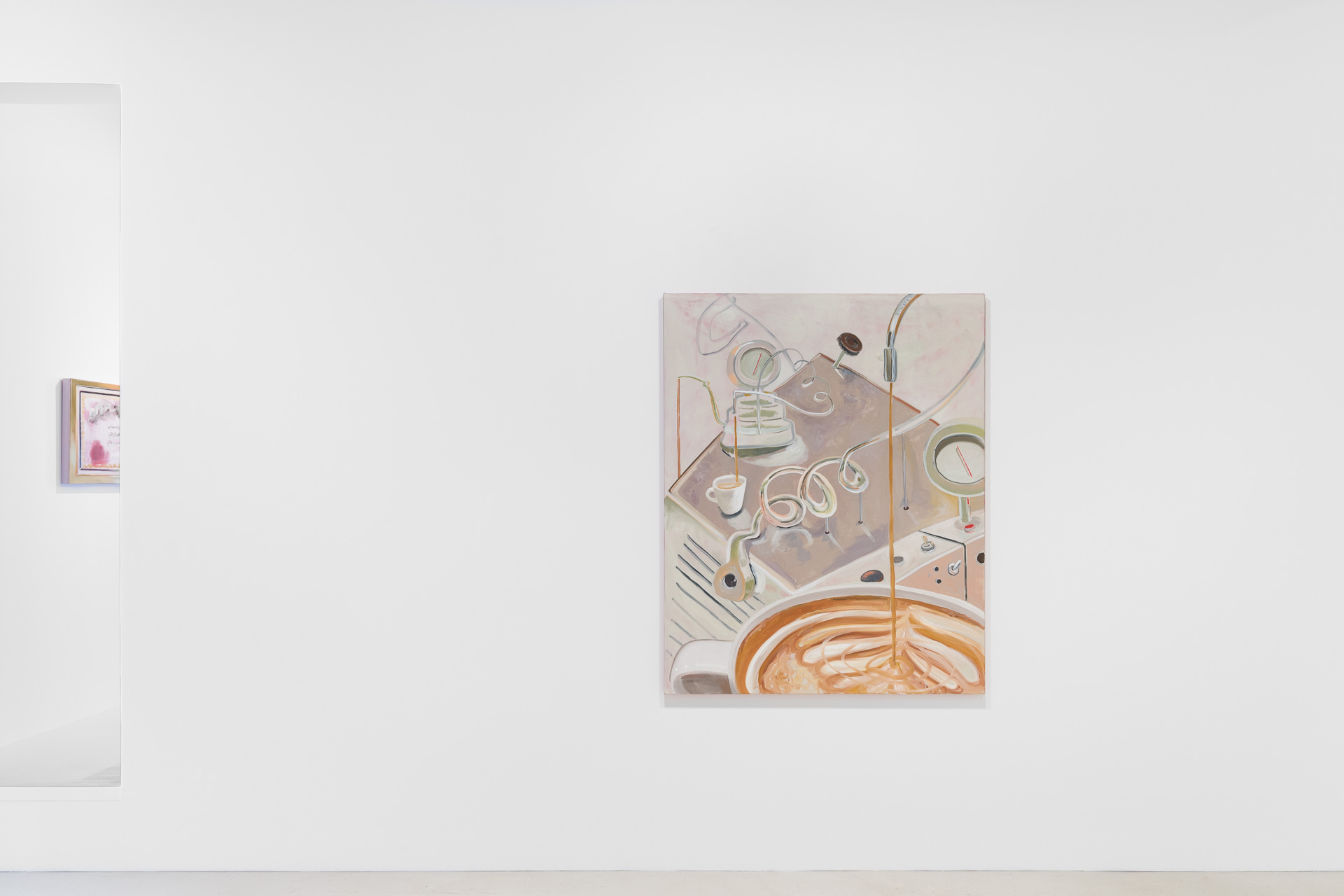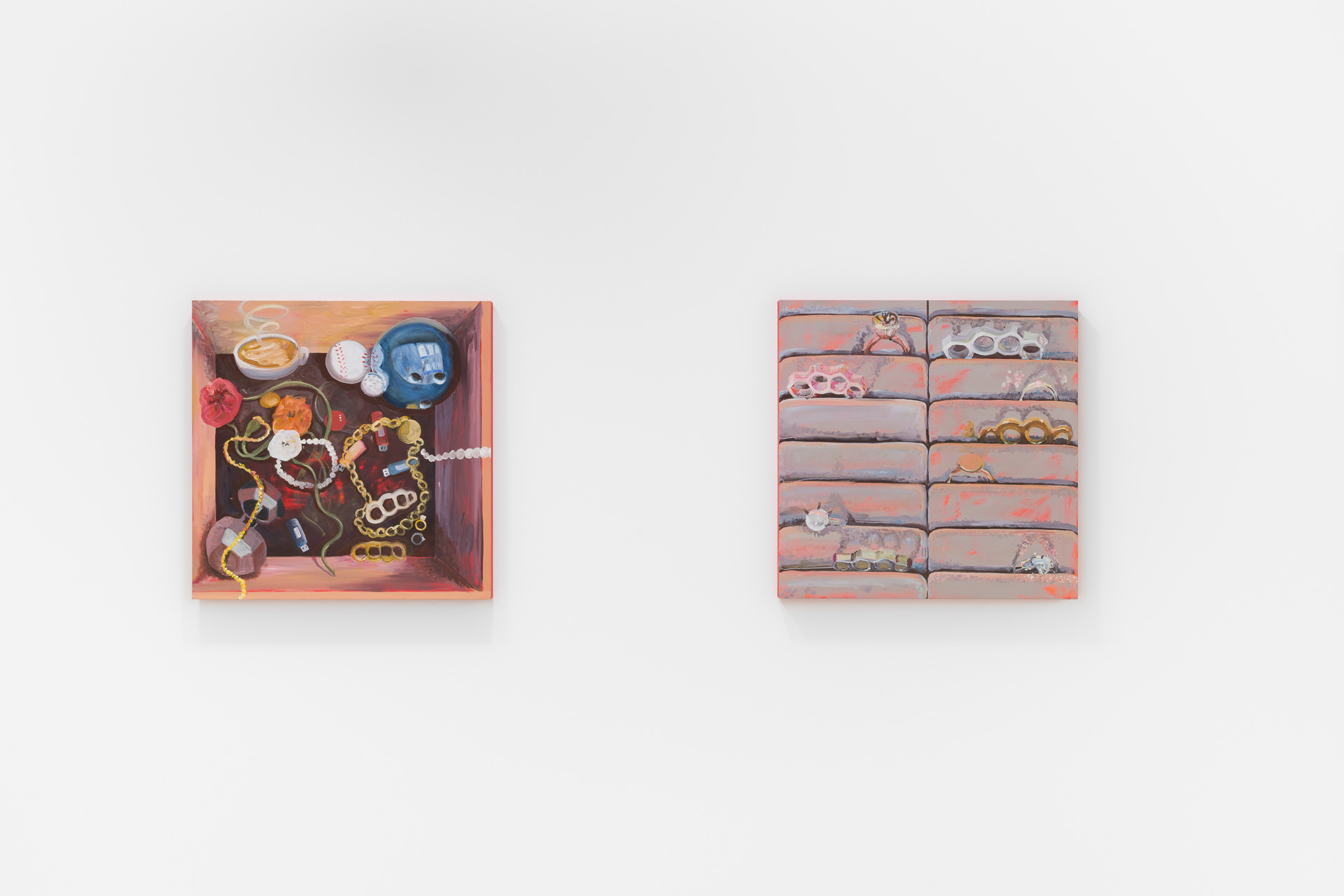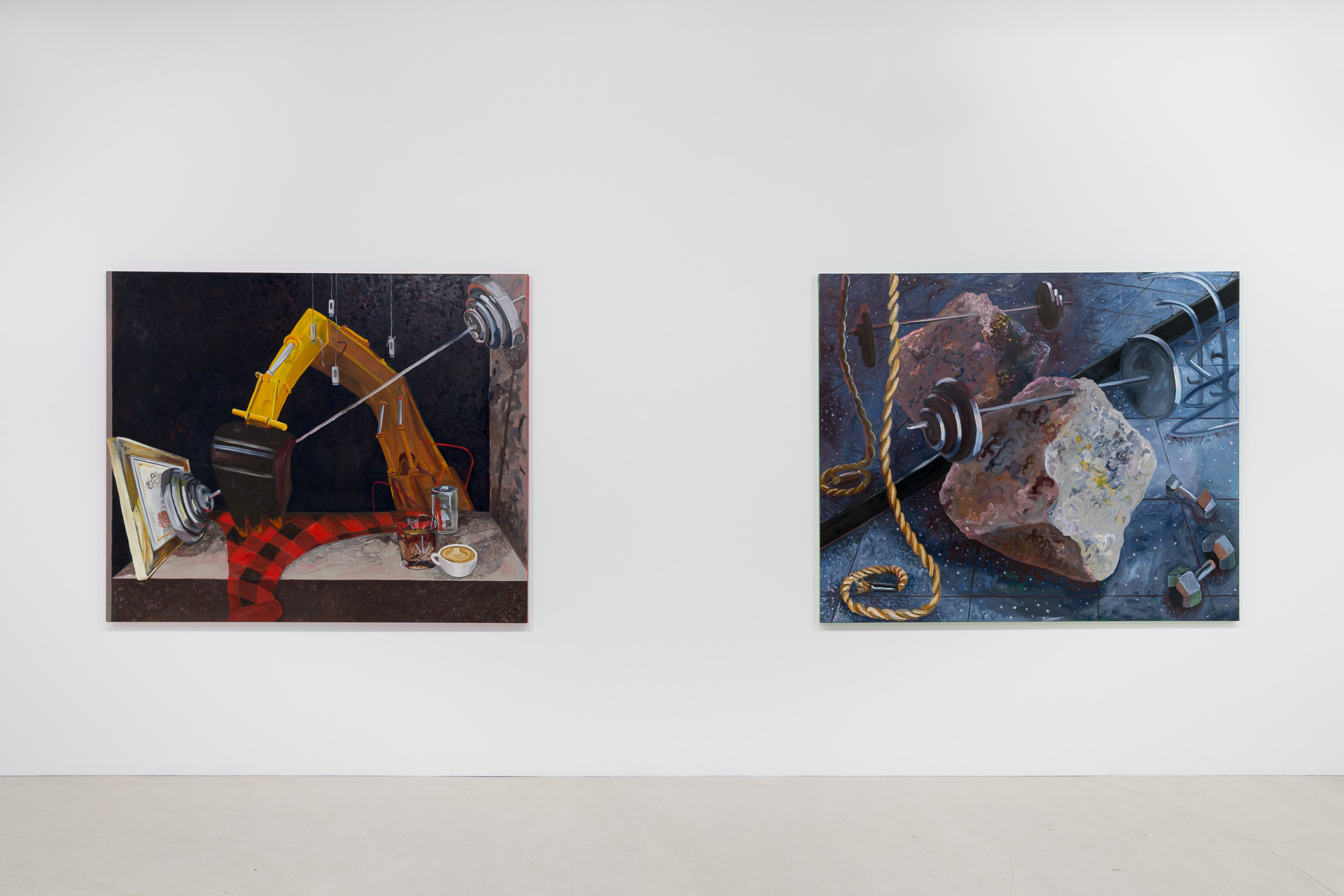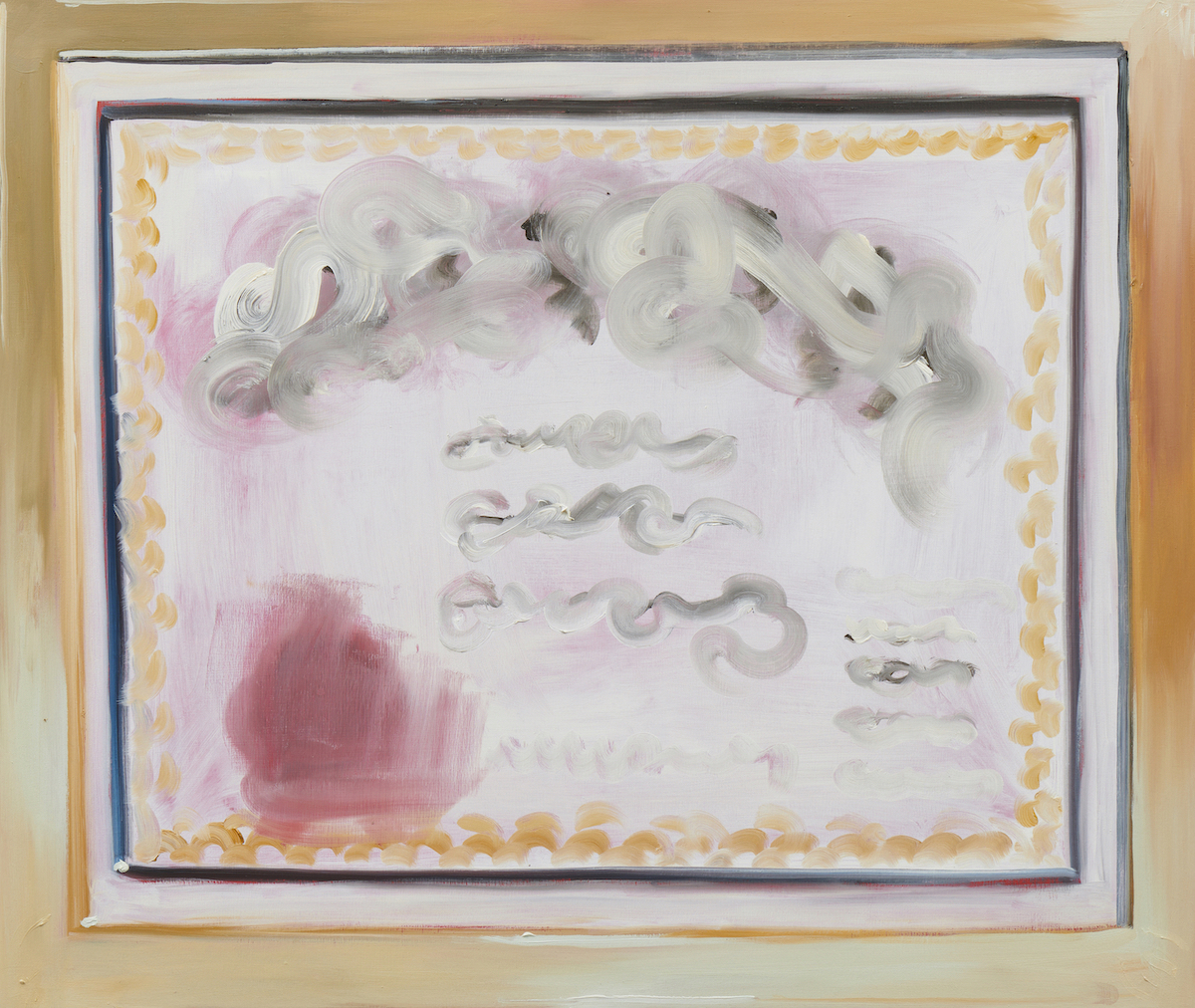Amber Boardman: Dude
Toyah Webb
I make a point of avoiding commercial galleries. They provoke the same sense of guilt as a designer shoe shop: I know that the staff know that I am not going to buy anything. My presence in these spaces is ghostly at best—there but not there, a secondary consumer left to haunt Depop and Facebook marketplace. So I am not surprised when the gallery assistant at Chalk Horse looks me up and down, nods briefly, and retreats into the back room to continue their phone conversation. Naturally, I eavesdrop. The conversation orbits around a dude, who may or may not be entangled in a love-plot: the tone is tense, he has done something that he shouldn’t have. But without context, the dude remains a sonic composite. Similarly, Amber Boardman’s Dude emerges—through a constellation of hiking gear, jewellery, sporting paraphernalia, and coffee cups—as the composite subject of the artist’s still lifes. Yet a subtle slippage in the catalogue essay authored by Boardman reveals this fictional dude to be the (fictional?) paintings’ progenitor: “This dude is creating these still lifes as a way of coping with the events of everyday life. He goes to work, comes home, tries out new hobbies, makes love, and all the while turns these experiences into his art.” Boardman’s dude is first a subject of the artist, then a subject as the artist.

Boardman’s painting practice is heavily informed by fiction, as well as the internet and her work as an animator for Cartoon Network’s (adult swim). In her catalogue essay, Boardman emphasises how Dude’s twenty-two paintingsform a cohesive narrative about her eponymous subject. However, I am more interested in the stories the paintings tell about the objects they depict, and the stories these objects might tell about painting. Pile of Pawn Shop Engagement Rings’s (2023) canvas is dominated bya towering cake of gold and silver rings on a glass counter, below which lie rows of pawned watches; Spilt Milk Crypto Fortune (2023)shows a birds-eye view of a filing-cabinet drawer, empty besides three USB sticks and what I can only assume is a puddle of milk; Box of Abandoned Interests (2023) (reminiscent of my kitchen’s “misc” drawer) contains an electric blue bowling ball, a steaming coffee cup, a tangle of gold chains, more USBs, and a pair of pastel knuckle-dusters. These knuckle-dusters appear again in Brass Knuckle and Wedding Ring Collection (2023), sandwiched between the pink-plush pillows of a ring display box. As a teenager I spent my pocket money on cheap silver rings, including the same Claddagh ring that Angel gives Buffy for her seventeenth birthday. These rings would stain my fingers green: a kitsch romance turned sour. From market to pawn shop, the objects in Boardman’s paintings similarly index the beginning and end of love’s encounter—what is drawn into the erotic circuit, then cast out as love’s material refuse. Even the bowling ball becomes a potential libidinal signifier.

Coined by Jean-François Lyotard in 1974, the “libidinal economy” is the name given to the erogenous currents that stimulate or suppress the political economy (capital, reason, commodity, data). If money is what makes the world go round, desire is its nocturnal slope: a wild, unknown lacuna. Although “still” on the canvas, Boardman’s objects bristle with a libidinal energy that threatens to overwhelm both definition and quantification; the transparent tubes in Red Hot Sculpture (2023)are like worms exploding from the proverbial can, while those in Unruly Sculpture (2023)seem to be imploding beneath their own pressure. Looking at Expanding Sculpture, I’m reminded of a meme I saw on Twitter with the caption “name one thing in this photo.”The photo in question looks normal at first glance, just a pile of objects in the corner of a room. I think I can make out an R2-D2 figurine, Paddington bear, and some earrings, yet each object bleeds into the next. This is distinct from defamiliarization, which makes a familiar object unfamiliar vis à vis its own attributes. In this meme, the viewer has no point of reference to begin with. And if nothing is familiar, how can it be made unfamiliar? All that’s left is a vague aura of excess—a soup of love and money.

Hanging in Chalk Horse’s window, Earthwork (2023) depicts a disembodied digger arm reaching over a road to get at what look like rows of butterhead lettuce. I am standing in front of The Masculine Urge to Paint a Still Life (2023), inside the gallery. On the large canvas before me, the digger arm from Earthworks is re-contextualized, frozen mid-scoop over a black and red Swanndri. I recognize objects from other paintings: the coffee cup, USBs, and a silver barbell. Then I notice something strange. Propped up behind the barbell is a small painting¾a version of the IRL painting on the wall behind me. Realizing that I’ve been caught out, I do a comical double-take, then laugh out loud. Authority Expert (2023) is the size and shape of an A3 piece of paper, with a curly border and pink smudge in the bottom-left corner that suggest a certificate or university testamur. While I’m amused, there is also something eerie about it. I look at The Masculine Urge as Authority Expert watches me look—an expert at its own observation, an authority on its (re)painted iteration. I get the feeling that the paintings know something I don’t. It’s their world, and the critic is just living in it.
In Dude’s catalogue, Boardman notes that the detritus from one painting often becomes “fodder for another,” with objects translated and tessellated across canvases. Yet the appearance of Authority Expert within The Masculine Urge complicates this relation. As Authority Expert transforms into painterly detritus—”fodder” for The Masculine Urge—the two paintings form a self-referential loop that obfuscates their origins. Is the version of Authority Expert wedged behind the barbell a re-representation of the “original” on the gallery wall? Or is this “original” in fact a copy of the painted-painting? Although the conventions of the still life genre imply that the IRL painting came first, it’s impossible to be sure. The hen’s egg hatches and it’s turtles, all the way down.

I turn into a detective, searching for traces of other detritus paintings. Authority Expert appears again, mounted above the bed in Bull and China Shop (2023), but otherwise the paintings keep to themselves. My attention keeps returning the USB-sticks: what’s on them? My (speculative) bet is JPEG files of Authority Report, paint reduced to pixels and reproduced as poor image. In her influential essay, “In Defense of the Poor Image,” Hito Steyerl defines the poor image as:
a copy in motion. Its quality is bad, its resolution substandard. As it accelerates, it deteriorates. It is a ghost of an image, a preview, a thumbnail, an errant idea, an itinerant image distributed for free, squeezed through slow digital connections, compressed, reproduced, ripped, remixed, as well as copied and pasted into other channels of distribution.
But importantly for Steyerl, the poor image also possesses radical potential, embodied by every pirate, hacker, and art school renegade. The low resolution of the poor image means that it is able to be transmitted via subterranean, libidinal, anti-capitalist channels. In this context, Boardman’s USB-sticks collectively function as the back door to the commercial gallery—hidden in plain sight like a purloined letter. Self-reflexive about their double-status as both commodity and work of art (art as commodity), these USBs reveal a glitch, through which the commodity can be reproduced, mass-distributed, torrented, and pirated. You wouldn’t steal a car, but you might download a painting.
After visiting Chalk Horse, I attend a screening of Sara Cwynar’s films at the Art Gallery of New South Wales with the tagline “Sara Cwynar: From Walter B to Kim K.” Recycling theoretical references, ebay objects, actors, and narrators across the four short films, I half expect to see Authority Expert in one of Cwynar’s riotous assemblages. Instead, a fragment of dialogue jumps out at me: “As soon as you buy something, you lose the power to buy something.” In other words, you cannot buy what you already have. I’m immediately reminded of Boardman’s Pile of Pawn Shop Engagement Rings. In a pawnshop, an object is deposited as security for money lent, so that the customer isn’t selling a commodity, but borrowing against a commodity they already own, otherwise known “collateral.” When the credit is repaid (with interest), the collateral is returned. I can’t help thinking about the parallels between the pawnshop and the commercial gallery, which charges interest on its collateral, otherwise known as “commission.” But Chalk Horse represents Boardman, not her “dude,” who knows that a poor painting on a USB lurks outside the capital relation. You don’t buy it, and this is its power.

Toyah is a writer and PhD candidate living on Gadigal land. Her writing can be found in Runway Journal, Cordite, and Minarets.


